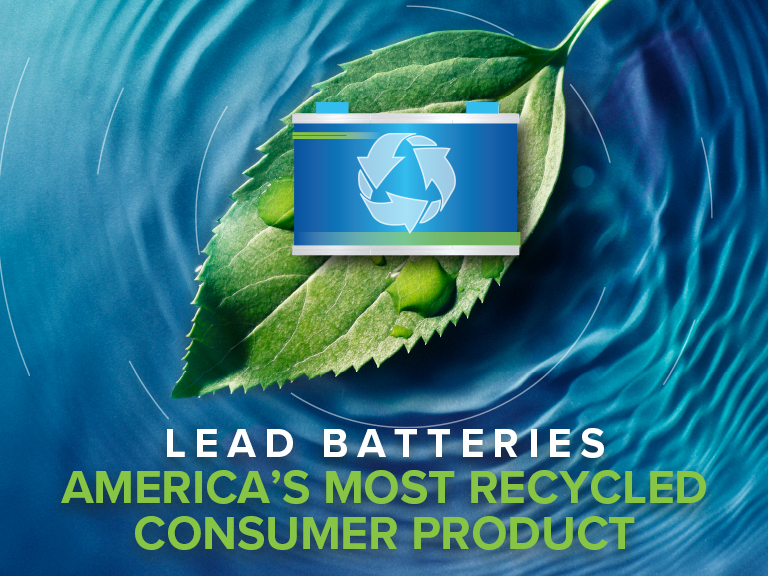
Most people think plastic, aluminum or paper reign as the most recycled consumer product in America. Not so. On America Recycles Day, November 15, we like to celebrate the real sustainability superstar – lead batteries.
It’s official, too. The U.S. Environmental Protection Agency (EPA) recognizes lead batteries as the most recycled consumer product in the U.S. Furthermore, lead batteries will continue to grow and perform as the most sustainable battery chemistry.
A World-Class Model of Circularity
The lead battery industry has been recycling batteries for a century and developed a truly circular battery manufacturing system. Using its large network of recycling distribution centers and an established closed-loop system, the industry hopes to serve as a circular economy model to new battery chemistries.
With a 99% recycling rate, nearly all used lead batteries are recycled. Each year, more than 130 million used lead batteries are recovered and recycled, rather than heading to landfills. At their end of life, lead batteries are separated into three key components: lead, plastic and acid, which are then reused to manufacture a new lead battery and restart the cycle of use-recycle-remanufacture.
Typically, a new lead battery is comprised of 80% recycled material. Much of that recycling occurs within the U.S. where the industry is highly regulated and supports a strong domestic manufacturing sector. It provides 26,000 clean-energy manufacturing jobs.
Another bonus: This ability to recycle lead battery componentry domestically is essential to the nation’s focus on securing a reliable, domestically sourced supply chain to manufacture batteries and meet the growing needs of both energy storage and a low-carbon future.
Drastically Reducing Resource Requirements
The environmental success of lead batteries is proven, especially when compared to the very low recycling rates of, for example, lithium-ion batteries (15% or less).
Only a small portion of the materials in a used lithium battery can be economically recovered for reuse. Thus, many of the materials needed to manufacture a typical 1,000 lb. electric vehicle (EV) lithium-ion battery must be sourced from raw ore – nearly 90,000 lbs. of ore per vehicle, by some estimates – and mostly from overseas.
That’s in contrast to a lead battery where the lead has a high intrinsic value, is infinitely recyclable, and is returned to the supply chain to make new batteries or other products. In fact, 73% of the lead required for U.S. manufacturing needs is produced by the U.S. lead battery recycling industry.
Our industry has proven that by embracing responsible, domestic recycling, a battery manufacturing industry can dramatically reduce its resource requirements and simultaneously increase its independence from imported raw materials.
Lead Batteries are Critical in EVs
The low-carbon future envisioned by global leaders recently in Glasgow will put a greater emphasis on EVs. That will expand the market for the types of batteries we rely on for transportation and energy storage.
There’s no argument that EVs will change our way of life, but that doesn’t mean lead batteries will go away. Vehicles are just one part of the global battery market, which, today, is about $90 billion in value, of which 60% is lead batteries.
In 2019, sales of battery electric and plug-in electric vehicles surpassed the 2 million mark, yet were still only about 2.6% of global car sales. Research from Deloitte Insights predicts EV sales will reach 31.2 million by 2030, about a 32% share of total new sales. Although EV sales will increase, their penetration in the U.S. car parc by 2030 is minimal, at just 4%.
Also consider that, in addition to lithium batteries, each EV contains an essential 12V lead battery for critical functions. But these “low-voltage” batteries are anything but an afterthought. Rather, proven lead batteries are the technology of choice to provide the critical and reliable power needed for the vehicle’s radio, locks, doors, and life safety features, including airbags, hazard lights, anti-lock brakes, power steering and the car’s emergency system. Lead batteries provide the best solution for low-voltage EV applications and will be the first choice for that role in the future.
Acknowledging the Success of Lead Batteries
Policymakers, researchers and industry leaders must continue to weigh the true environmental costs of battery manufacturing. That includes mineral requirements and ways to achieve our nation’s electrification goals without becoming solely dependent on imports from mines in other countries.
We are certain that lead batteries will continue as the most sustainable battery chemistry. The industry’s remarkable sustainability story is to be celebrated on America Recycles Day and every day!







